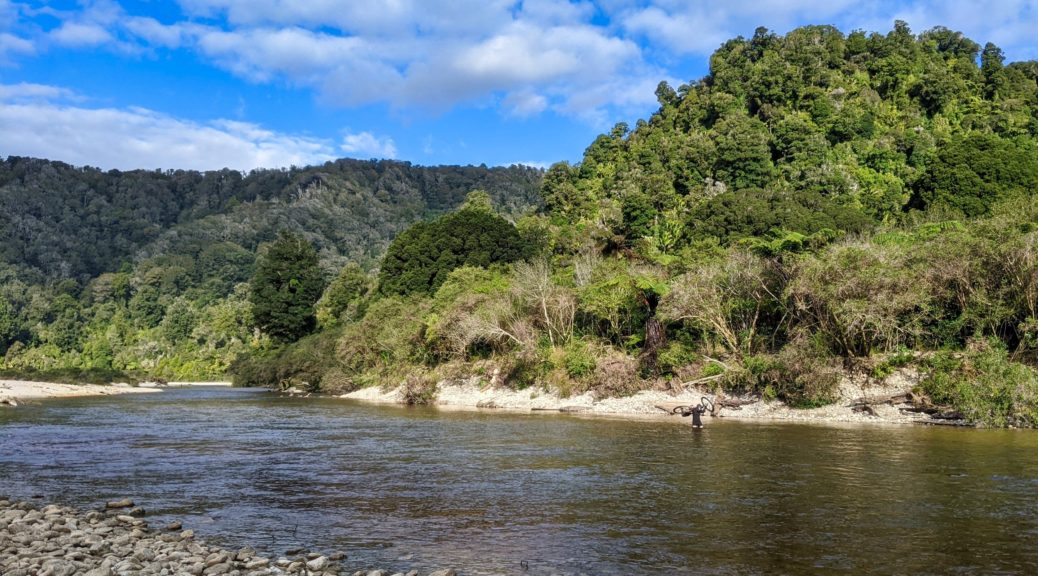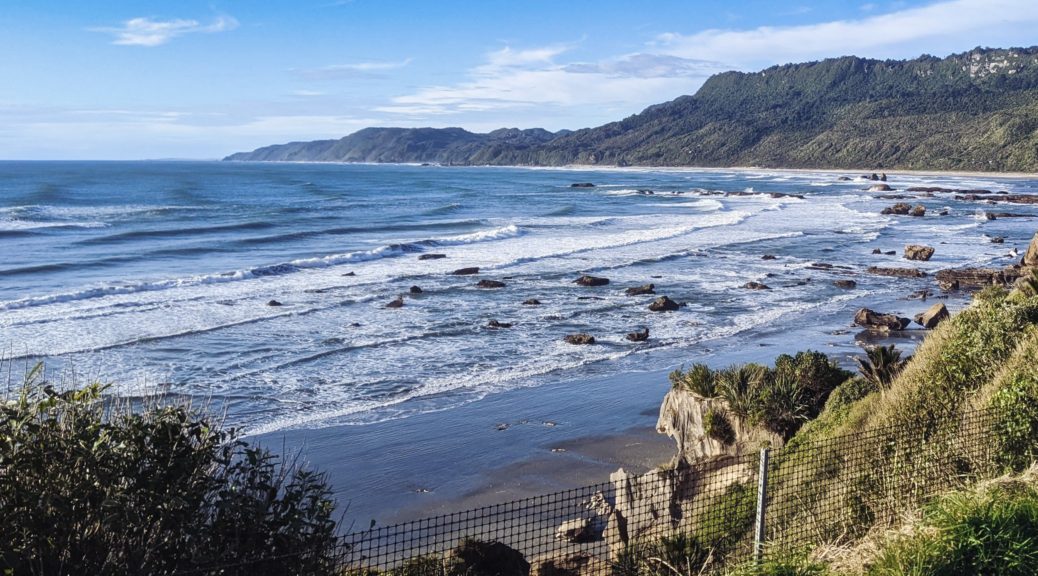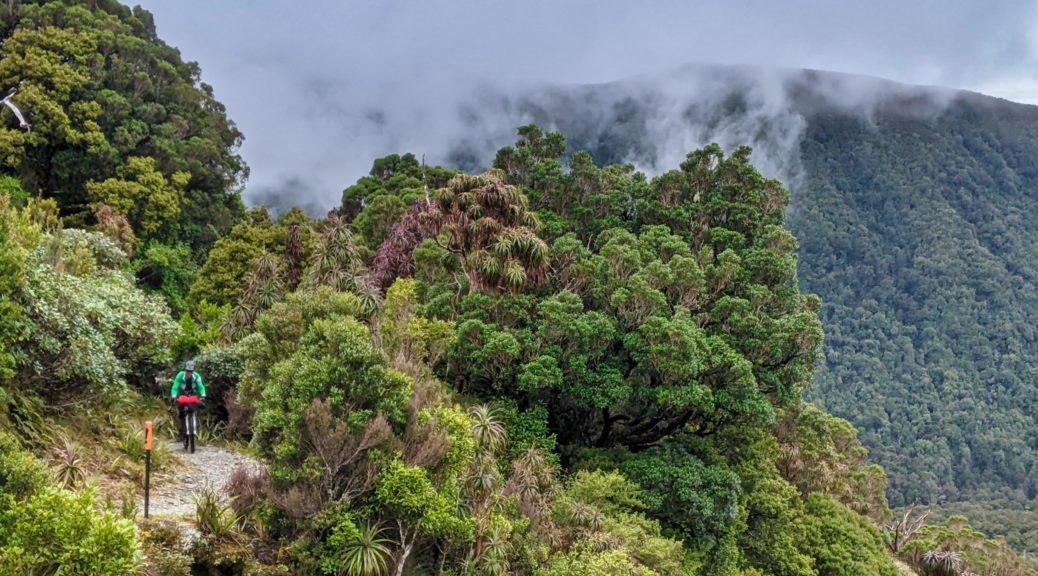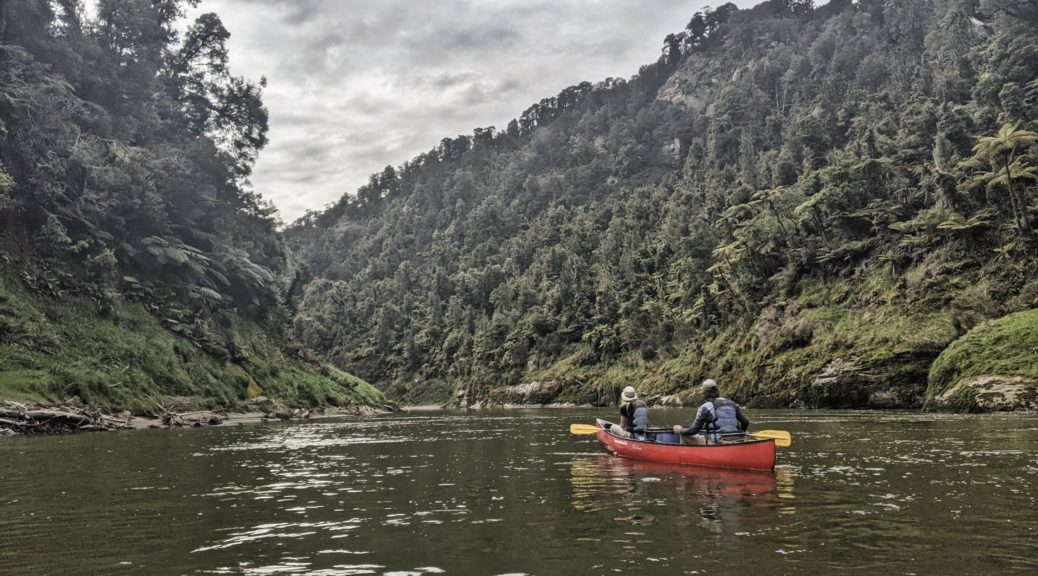After all the food we’d eaten in Karamea, I’m wondering how we even managed to leave at nine o’clock. Overnight rain had gone, so our purple patch of late-winter weather continued with a slight breeze helping us north during forty-five minutes of flat road. With timings and weather not throwing any spanners in our plans, we were planning two nights on the Heaphy Track – which I’ve easily ridden in a day a few times. I was very much looking forward to spending the time to go slower and see more of the national park.
The unknown factor in our day being whether or not we’d be able to safely cross the Heaphy River – the large bridge over it having been destroyed in floods earlier in the year. Many days since any significant rain and plenty of time and contingency up our sleeves, we were going to give it a good look and see. Pete, and many others, had waded through the river with a bike before the bridge was built – so the plan was sound. We’d also heard of a big slip on the climb after the river, but that was being worked on.
 Heading for Kohaihai – can see the bluff in the distance.
Heading for Kohaihai – can see the bluff in the distance.
At the trail head we met someone also going to check out the damage and do a little trail work. We learnt of smaller slips on the coastal section, but were encouraged in our plan. Straight into the forest, and nikaus galore – they give such a tropical feel to the area, before the short climb up Kohaihai Bluff.
 A short diversion to the lookout – north along the beaches which we’d ride beside for the next two hours.
A short diversion to the lookout – north along the beaches which we’d ride beside for the next two hours.
 Back along Scotts Beach to Kohaihai Bluff.
Back along Scotts Beach to Kohaihai Bluff.
 Still a few bridges across the bigger creeks pouring straight out of the hills into the sea.
Still a few bridges across the bigger creeks pouring straight out of the hills into the sea.
 Nikaus! Tall ones at that.
Nikaus! Tall ones at that.
 A clear section of trail – much of it was littered with big nikau fronds, other tree fall and wash from big, stormy tides.
A clear section of trail – much of it was littered with big nikau fronds, other tree fall and wash from big, stormy tides.
 What a day, what a place! Again, with the bridge out, we were the only ones going through and pretty much had it to ourselves.
What a day, what a place! Again, with the bridge out, we were the only ones going through and pretty much had it to ourselves.
 We did find a few small slips along the coast which required a bit of bike-carrying and -wrestling to clear – nothing too serious.
We did find a few small slips along the coast which required a bit of bike-carrying and -wrestling to clear – nothing too serious.
Shortly before lunch at Heaphy Hut, it was the turn of Pete’s rear tyre to spring a leak. Strangely a plug wouldn’t seal it, so it was a nice long lunch for me – chatting to a helicopter pilot who’d landed down on the beach.
 Lunch views. Tough day at the office.
Lunch views. Tough day at the office.
The next section of trail had been used even less, so there were still more obstacles to be negotiated – it slowed us a bit, but wasn’t much of an issue.
 More green beauty.
More green beauty.
This however…
 Bridge has definitely gone.
Bridge has definitely gone.
Scrambling down the bank, without bike, we quickly found this spot was much too deep. Further upstream, with a lot of bush bashing, it was far shallower – but quite rapid; unloaded we crossed successfully. I didn’t fancy being exhausted by hauling bags and bikes through the tangled bush before even attempting to get them across the river. The right bank was far more open, so it was easier to head downstream, past the bridge site, and investigate below the confluence of the Lewis. The rapids here were easier, and just above them Pete found the best crossing site. Certainly was worth taking our time to find this spot.
We returned to our bags and bikes upstream and brought them to the crossing spot. It all went swimmingly, except in the literal sense, and the crossing was easier than the Mackley three days before. Generally it was mid-thigh and, once the spot was found, there was nothing to it.



 Over the Lewis to the missing hut (such a shame, it was a classic and actually had character – unlike the big new huts on the track) and the strange new shelter perched higher.
Over the Lewis to the missing hut (such a shame, it was a classic and actually had character – unlike the big new huts on the track) and the strange new shelter perched higher.
After poking around the shelter perplexed (why reduce the facilities available in unforeseen circumstances – i.e. the river is up?), there was two hours of riding and seven hundred metres of climbing to James Mackay hut. Along with whatever obstructions we found…
A few minor trees to carry over, a quarter of the way up we found a much larger tree, and its associated eco-system, over the track. Off the bank wasn’t safe, up the other bank was an impenetrable mess. So over the tangle it was. Cue twenty minutes of clambering and sliding over all manner of branches and vines, heaving bags and bikes in our chain of two to the other side.
 Where has Pete gone?
Where has Pete gone?
 Oh, there he is.
Oh, there he is.
 Am I grinning far too much in this situation due to the absurdity of this self-inflicted episode, or due to it being far easier than the Nydia bike-dismantling with a buddy to help, or because it’s a grand day in a fantastic national park? All three I’d say.
Am I grinning far too much in this situation due to the absurdity of this self-inflicted episode, or due to it being far easier than the Nydia bike-dismantling with a buddy to help, or because it’s a grand day in a fantastic national park? All three I’d say.
 Through; yes there’s a track either side of – and under – that.
Through; yes there’s a track either side of – and under – that.
No sooner were we back on the bikes we spotted motorbike tracks – the trail crew had got this far, encouraging! We were soon seeing evidence of all the work they’d been doing (based at the hut at the top of the hill, they were working down). So while we had to deal with that fallen tree, we found the track had been reinstated through the slip and our progress was barely interrupted on the rest of the climb.
 Through the slip.
Through the slip.
For the consecutive days, we arrived at our destination comfortably before dark – much preferred. The hut is so large that we had an entire bunk room each, but it was a challenge to heat devoid of warmth and charm as it is. The trail workers were based in the warden’s accommodation just up the hill; so surprised to see people in the main hut, they came down for a chat. Turns out they’d got to the big fallen tree last thing at the day, took one look at it and left it for the following day – damn! Another successful day of our trip going to plan, great to be out in such weather enjoying little traffic on a popular track.


 More nice rocky trail, heading towards Croesus Knob – must wander up there one day.
More nice rocky trail, heading towards Croesus Knob – must wander up there one day. Towards Moonlight Tops. Spot the trail, left to right.
Towards Moonlight Tops. Spot the trail, left to right. I do enjoy this view, anticipating getting to the escarpment on the right, and then riding very close to the top and edge of it. Not least for the goblin forest that covers this section.
I do enjoy this view, anticipating getting to the escarpment on the right, and then riding very close to the top and edge of it. Not least for the goblin forest that covers this section. The mossy trees don’t have quite the same atmosphere when there’s no mist sneaking its tendrils through; but certainly not complaining about such a clear sky!
The mossy trees don’t have quite the same atmosphere when there’s no mist sneaking its tendrils through; but certainly not complaining about such a clear sky! Continually distracted studying the old forest.
Continually distracted studying the old forest. Popping out of the forest briefly to see the sea.
Popping out of the forest briefly to see the sea.
 Ooh, the emergency shelter has been upgraded considerably. Digger garage this end, enclosed shelter other end – another good bivy spot.
Ooh, the emergency shelter has been upgraded considerably. Digger garage this end, enclosed shelter other end – another good bivy spot. With no one else on the trail, I didn’t feel rushed to get off the bridge beneath this waterfall and managed a couple of snaps this time.
With no one else on the trail, I didn’t feel rushed to get off the bridge beneath this waterfall and managed a couple of snaps this time. One of the more tightly-switchbacked sections through some enormous boulders.
One of the more tightly-switchbacked sections through some enormous boulders. It would be a shame not to stop at this thoughtfully provided seat.
It would be a shame not to stop at this thoughtfully provided seat. As I was the previous time, I was transfixed by the tight contours of this peak – Lone Hand. The topo map is a mess of packed, twisted lines.
As I was the previous time, I was transfixed by the tight contours of this peak – Lone Hand. The topo map is a mess of packed, twisted lines. Such a nice, still afternoon there was no need to have afternoon tea inside the last hut.
Such a nice, still afternoon there was no need to have afternoon tea inside the last hut.


 Calm, clear and mild for a late-afternoon ride – Southern Alps off in the distance.
Calm, clear and mild for a late-afternoon ride – Southern Alps off in the distance. Heading into Fox River.
Heading into Fox River. Getting towards the northern end of the Paparoas.
Getting towards the northern end of the Paparoas.
 Pleased to have the bags back on, and keen to see how a suspension fork goes on these technical trails. I survived rigid
Pleased to have the bags back on, and keen to see how a suspension fork goes on these technical trails. I survived rigid  The day’s destination – them there hills.
The day’s destination – them there hills. We joined the West Coast Wilderness Trail along the coast to Greymouth, where it took an age to buy a hut ticket.
We joined the West Coast Wilderness Trail along the coast to Greymouth, where it took an age to buy a hut ticket. Oh, is that it? Of course, DOC *eyeroll. We saw much worse than this on, open, main West Coast roads. Clearly, we passed this easily on bikes.
Oh, is that it? Of course, DOC *eyeroll. We saw much worse than this on, open, main West Coast roads. Clearly, we passed this easily on bikes. Time for what must be one of my favourite climbs – the old Croesus pack track.
Time for what must be one of my favourite climbs – the old Croesus pack track. Ooh, this is new and more colourful than I’m used to for such things.
Ooh, this is new and more colourful than I’m used to for such things. Much of the two hour, ten kilometre climb is graded like this (around six percent) and the surface is so long embedded that it holds up well in the local climate.
Much of the two hour, ten kilometre climb is graded like this (around six percent) and the surface is so long embedded that it holds up well in the local climate. A couple of bridges to cross before following the true left of Blackball Creek for some time.
A couple of bridges to cross before following the true left of Blackball Creek for some time. Love the moss and general green – so nice to be back in the bush, I miss it.
Love the moss and general green – so nice to be back in the bush, I miss it. There used to be a hotel here. Heading for that ridge up there.
There used to be a hotel here. Heading for that ridge up there. Bits of the trail are a bit chunkier.
Bits of the trail are a bit chunkier. Emerging from the bush, almost there.
Emerging from the bush, almost there.
 Top Hut, perfectly good overflow shelter if the main hut happens to be full
Top Hut, perfectly good overflow shelter if the main hut happens to be full  Over the Grey River to Lake Brunner and the Southern Alps beyond.
Over the Grey River to Lake Brunner and the Southern Alps beyond.
 Weather looking good first thing near Taumaranui.
Weather looking good first thing near Taumaranui.





 A leisurely breakfast.
A leisurely breakfast.

 Suddenly, a substantial concrete bridge over a deep canyon.
Suddenly, a substantial concrete bridge over a deep canyon.
 Contemplating the Matemateaonga Track start/end and whether I’d ever return to walk it (or hike-a-bike it, remembering
Contemplating the Matemateaonga Track start/end and whether I’d ever return to walk it (or hike-a-bike it, remembering 
 At Ngaporo Campsite, taking the opportunity to work through more snacks and check the rapid below.
At Ngaporo Campsite, taking the opportunity to work through more snacks and check the rapid below. Somewhere up there, past the mud, is Puraroto Cave.
Somewhere up there, past the mud, is Puraroto Cave. Curious mud stalagmites from the dripping cave ceiling.
Curious mud stalagmites from the dripping cave ceiling. Maybe it wasn’t past the mud, violently shoe-grabbing mud at that.
Maybe it wasn’t past the mud, violently shoe-grabbing mud at that. Mushrooms!
Mushrooms!